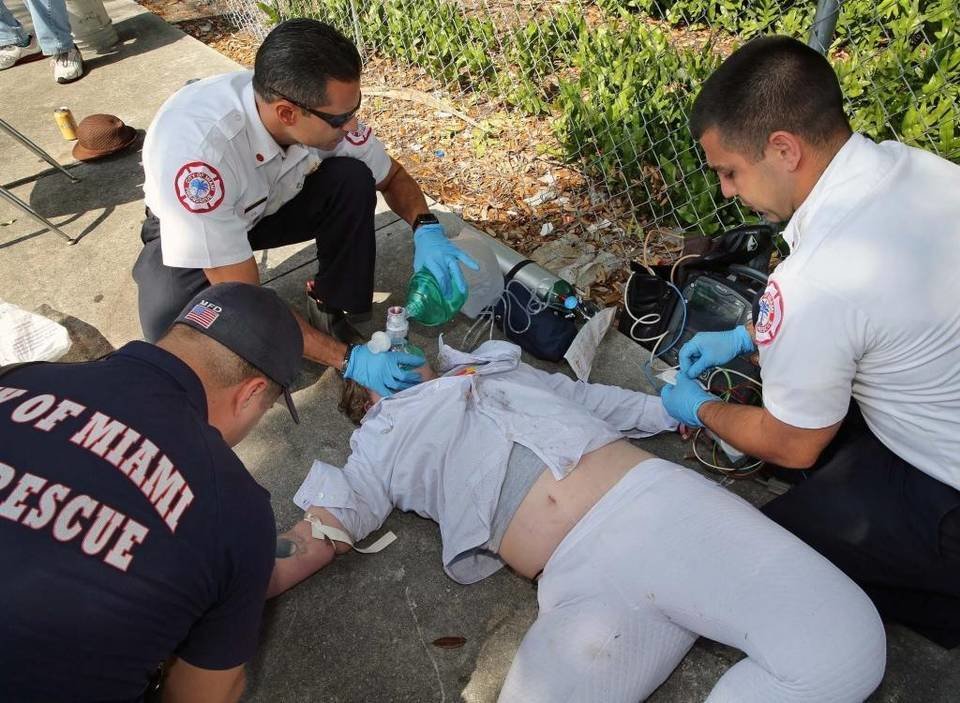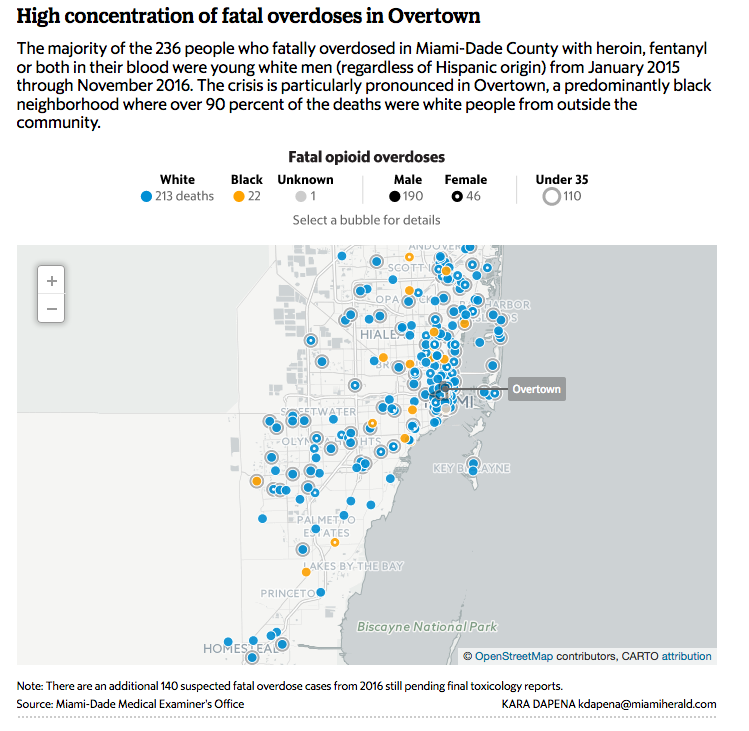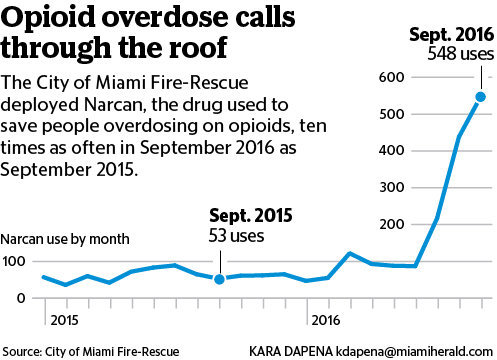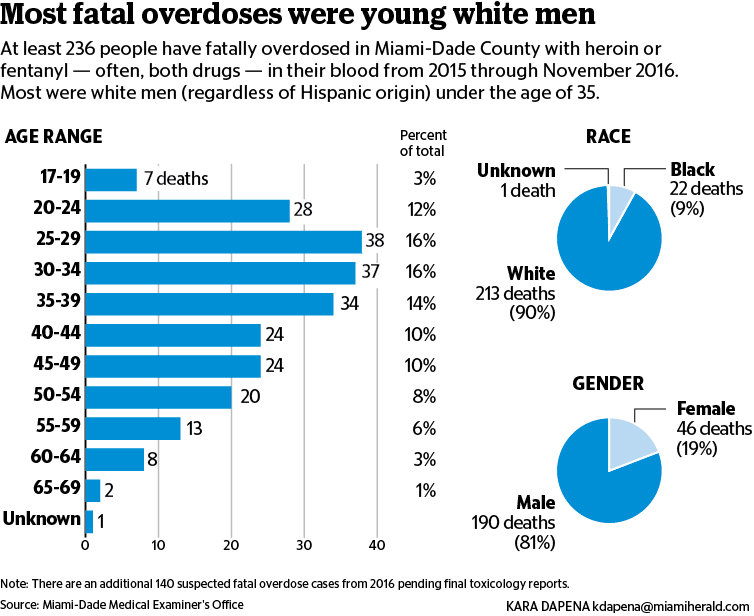
On a sunny morning late last month, a 43-year-old homeless woman named Mary crumpled to the sidewalk along Northwest 17th Street, vomit smeared across her T-shirt and hair. Within minutes, Miami Fire-Rescue paramedics injected her twice with the life-saving antidote known as Narcan.
As they lifted her still-unconscious body into the ambulance, a telltale sign was revealed. On the sidewalk lay a silver burnt spoon used to liquify the powder heroin.
Mary was lucky to survive, and stories like hers have become increasingly common for overwhelmed first responders on the frontline of South Florida's opioid crisis. Newly released statistics show that in the first nine months of 2016, the Miami Fire-Rescue stations in the neighborhood used Narcan nearly 1,000 times - nearly double the rate of last year.
But they don't always make it in time.
Since 2015, at least 31 people have fatally overdosed in Miami's Overtown neighborhood with heroin or fentanyl - often, both - in their blood. That makes it far and away the deadliest zip code for opioid deaths in Miami-Dade County. The city of Miami itself accounted for nearly a whopping 43 percent of all 236 county overdoses recorded since 2015.
And those numbers will rise dramatically - the Miami-Dade Medical Examiner's Office says there are 140 suspected overdoses from 2016 still awaiting final toxicology reports. Of those, 107 are believed to be overdoses involving carfentanil, an even deadlier cousin to fentanyl that is best known for its use as an elephant tranquilizer; 59 of those cases happened in the City of Miami.
The place addicts are dying tells only part of the story, however. Most of the victims aren't from the poor, predominately black community. They're white and Hispanic users lured to Overtown by cheap packets of heroin known on the street as "boys." They can be had for as little as $10 at drug dens.
Rehab gone wrong
That's the stuff that killed Cody Stewart, a young man who wanted to be a welder but got derailed by drugs in high school. He had moved from Pennsylvania to enter rehab in Pompano Beach.
But after repeated relapses, Stewart made his way to Overtown, where in March he collapsed in the brush behind a ramshackle apartment building on the 200 block of Northwest 13th Street. An autopsy revealed Stewart died of heroin and fentanyl, a synthetic and far more powerful version of the narcotic. He was 23.
"The day I was looking for him, I called and his roommate said he was probably in Overtown because they get cheap drugs there," said his mother Stacy Stewart, of North End, Penn. "He was a good kid, sweet and caring. But once he started the drugs, it overtook him."
The rise in opioids - heroin, fentanyl, carfentanil and other synthetic versions - has become a national epidemic, laying waste to families from the Midwest to New England. The demand, public-health experts believe, was an unintended ripple effect of the crackdown on another addictive scourge: widely abused prescription pain killers such as Oxycontin. Florida's notorious "pill mill" clinics helped drive that explosion, hooking thousands on cheap and illegally distributed pills before regulators finally cracked down.
Synthetic drugs, cheaply made in China and often mailed to the United States in nondescript packages, have increasingly filled the void, as chronicled in the Miami Herald's 2015 Pipeline China series.
Many of the overdoses in Miami have been blamed on heroin laced or substituted with fentanyl, which can be up to 50 percent stronger than heroin. Carfentanil itself is even deadlier - the U.S. Drug Enforcement Agency, in a public warning issued in September, estimated it is up to 1,000 times stronger than fentanyl.
Many addicts don't realize what they are smoking, snorting or injecting.
"The problem is bad and it's getting worse," Miami Fire-Rescue Chief Maurice Kemp, flanked by law-enforcement officials, said at a press conference called in September to highlight the growing dangers of fentanyl.
Miami hit hardest
His city has been hit the hardest. Through the first nine months of 2016, Miami Fire-Rescue had deployed Narcan nearly 1,700 times citywide, a stunning increase. In all of 2015, they only used the drug 771 times.
While Overtown and the surrounding areas in the city of Miami has seen the most deaths, virtually every corner of the county has recorded overdoses. Miami-Dade Fire-Rescue, a much larger department, also saw a dramatic increase in the first nine months of 2016, using the drug 966 times, up from 634 all of the year before.Across Miami-Dade, there have been at least 236 overdose deaths involving the drugs in 2015 through the end of November of this year. The dead have almost all been white or Hispanic - just 21 were black.
Many were transients and chronic drug abusers. Hugo Carranza, 49, snorted heroin in February, fell asleep on a milk crate under a bridge on Old Cutler Road and never awoke. The cause of death: a lethal brew of fentanyl and alcohol.
Some were young, like Miami's Christian Fernandez, 18, who planned to attend Santa Fe College in Gainsville after entering a drug rehab program upstate. But on Aug. 21, he passed out at a friend's home on Key Biscayne, after taking pills friends believed to be Oxyontin. The next day, Fernandez died at Mercy Hospital after suffering seizures. Tests showed he died of heroin and cocaine.
At least one overdose death has been linked to drugs sold in West Perrine in deep South Miami-Dade, where Miami-Dade police last week raided the home of a man believed to have been selling carfentanil.
Law enforcement officials, however, believe dealers in Overtown have done much of the supplying for the rest of the county.
The storied predominately African-American neighborhood was once a thriving community with teeming nightlife and restaurants, before the the construction of Interstate 95 in the 1960s divided and depopulated the neighborhood and crack-cocaine and poverty took its toll.
For years, Overtown has been known for drug sales. In the past couple months, Miami police detectives, along with federal and county counterparts, have quietly arrested more than two dozen sellers and drug-gang lieutenants — most with long rap sheets — in a campaign called Operation Overtown-Swamp City, an ode to one nickname for the neighborhood.
Across Overtown, detectives have sent in confidential informants and undercover detectives, and raided known dope holes to try and stymie the flow of opioids.
At the Madison View Apartments, a gleaming affordable housing tower on the 600 block of Northwest Fifth Avenue, residents and management began complaining after users began overdosing in their parking lot. Detectives began watching the market across the street, watching user after user buy from a man identified as Alexander Fonseca, 31, who was arrested and is now awaiting trial.
Read the remainder of the article here.






Comment: Americans view opioids as biggest local drug epidemic in communities - poll